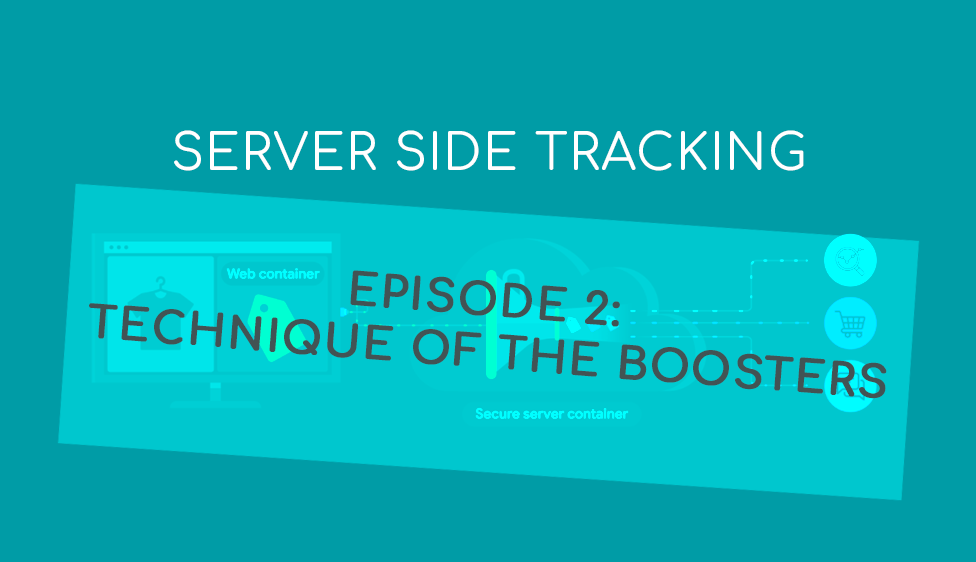If the title rings a bell, good job Padawan. 🤖⚔️

Here we are ready to jump into the second episode of Server Side Tracking, the saga. A story of heroes (i.e. our BoosterBox tracking team) who bravely face down the constant tracking challenges of an ever-changing online advertising landscape. Let’s ward off the Dark Side with our brand new lightsaber: SST!
If you have quickly recapped on episode one – top marks again Padawan. If you didn’t, because you already guessed we would offer a quick recap – nice move, you lazy clever clogs! But be aware, you can’t take shortcuts all the way if you want to become a Jedi.

Previously on…
Why bother with Server Side?
Privacy concerns
Server-side tracking can be more compliant with privacy regulations, compared to third-party web tracking scripts that can’t be strictly controlled and can scrape sensitive data or personal identifiers without your knowledge.
SST allows you to control what information is sent to which platforms. This prevents platforms from collecting data from your website that they are not allowed to. You can also either remove Personally Identifiable Information (PII) from the string before sending it to third-party platforms, or you can hash PII before sending it.
User name, user email and phone number can be considered as PII and by hashing/removing them before sending this data to platforms, users become more protected and tracking more compliant.
Data accuracy
Another advantage of server-side tracking is the increased data accuracy. Many browsers are already blocking third-party cookies and additionally users can use Adblockers, which prevent accurate tracking. Server side tracking circumvents some of these restrictions.
With SST, all cookies can be put in a first-party context. Imagine a space shield protecting your data from browsers’ limitations and ad blockers: “you have no power here, tracking enemy spaceships”!
Performance
So now it should be clear: it is not only a matter of enhanced privacy but also a matter of enhanced quality. SST increases the quality of data your website tracks, while enhancing the experience of your customers. With fewer third-party code and tracking tags, page load speeds automatically increase, improving the UX and potentially increasing the purchase funnel conversion rate.
Okay Queen of Naboo, what’s the catch?

True, SST does not come without pain points and drawbacks. Much like client-side tracking. So, let’s see the pros and cons of both:
CST pros
- Simple setup
Most platforms have client-side tracking settings ready. Plus, thanks to many tools like tag managers, tracking scripts can be added quickly - Provides detailed data
When a tracking script is loaded through the browsers, it gets a lot of data and sends it all to an external party - Lower costs
Client-side tracking is easier and so the workflow will be. Also, there are no costs connected to having and maintaining a server
CST cons
- Data blocked by browsers or ad blockers
Some browsers and ad blockers already block third-party cookies, so you’re missing data of some visitors and their precious behaviour. Longer term- think of the fact that Google will be revoking support for third-party cookies in 2024 and the impact this will have - Potentially higher load time
More tracking scripts means slower operations on the website- simple as that. If you maintain scripts poorly, the user experience might be ruined - Privacy risks
CST means little to no control over the data that is sent from scripts. PII can be easily accidentally forwarded to analytics platforms and that poses a threat to privacy compliance
SST pros
- Data ownership and full control
Data is sent to your server first, so you’re in charge of which data is sent to third-party platforms. Also, you can send data to your warehouse for further analysis for more data-driven decision making - Better user experience
The load is moved to the server, hence users’ browsers don’t have to do anything. This results in shorter load time, thus improving performance and UX - Not impacted by browser restrictions
Data collected through SST can’t be touched by browsers or ad blockers. This can lead to more traffic recorded and therefore more data to feed the algorithms with
SST cons
- Complex implementation
No cats under the table, for SST you will need support from your IT department to set up the server - Higher costs
It might be peanuts (depending on your data volume), but a server costs money
SST is more
This is our PoV, but hey!, you’re in our blog. Whose point of view were you expecting! In our opinion, SST is:
- More accurate
- More secure
- More reliable
And…
- It opens up a better opportunity for cross-device tracking
Cross-device tracking
We’ve said it many times. We call it “the messy-middle” and it is the super-complex path consumers take from first touch to the final conversion, involving a variety of multiple channels and devices. It is vital to understand off-domain and cross-device interactions to identify all the sources of traffic and therefore be able to run proper attribution.
Now if your customers are technically savvy and use ad blockers, your event tracking might not work properly. Similarly, if browsers are limiting the amount of collected data this will also be a barrier to accurate tracking. Poor tracking accuracy leads to non-data-driven decision making. Scary!

Technique of the Boosters
Now you have all the information about server-side tracking. We have provided you with the perfectly balanced lightsaber to cut through the Dark Side. Use the server-side tracking Force, padawan. 🤖⚔️ Now that we have covered ‘The Why’, let’s enter the heart of Episode 2 – ‘The How’!
Boosters’ paths
If you are curious about how we run server-side tracking at Booster Box, read on. If you’re not, we’ll pretend that it doesn’t bother us because we’re decent human beings but we might accidentally drop a spell on you. Just so you know, Sith undercover.
- GA tracking implementation
A typical tagging configuration relies on adding a GTM container in the page to send measurement data out. For SST, we’ll implement an additional server container that you and only you (well, maybe also us, but only for well-intentioned data-driven purposes to skyrocket performance) will fully control. You will have control over what data is retrieved, how it is stored and where it is sent. Long story short: using events, triggers and variables we can fire tags in the server GTM container and afterwards send the desired data from the endpoint to Google Analytics.
- Advertising platforms
-
- Meta Conversions API
This is the way to share offline and key web events with Meta. Data can be sent from your server and used by Meta to run more consistent and effective ads. This approach uses the Facebook Pixel and follows the below steps:
- Meta Conversions API
-
-
- Data is collected through GA4 Web Tag but not stored on third-party server
- Data is sent to first-party server container
- The desired (potentially more limited or hashed)data is sent to Meta thanks to API Conversions
-
-
- Google Ads Conversion Linker
Google Ads also has an option to send data collected from server side tracking to the advertising platform. Similarly to Meta, this approach also utilises GA4 tags and follows a similar flow.
- Google Ads Conversion Linker
- Come on shake your body baby do that COMBO
True, you can go for a vertical solution and implement SST for one platform only, or for GA only. But the best way to get an extra 5 -10% (according to our Boosters big-brains) of events tracked is to use a combo move. Providing multiple platforms with data collected server side increases the amount of data available for machine learning (in terms of bidding) can improve privacy compliance and feeds your campaigns with useful first-party data that you alone can leverage (Joey. Doesn’t. Share. Data!) *mic drop*

In a nutshell
- Server-side tracking will make you more privacy compliant, while keeping pockets full of extra-data
- Implementation is more complicated- true. But what are we here for?
- We run it both as GA tracking only and as advertising platform specific
- Using a complete approach you could increase tracked events by 5-10% (based on our experience)
- You might want to get in touch with us and start your server-side tracking implementation
- You didn’t realise number 3 is missing, you’re going back to check, and now you’re smiling because we got you- wait, we’re not on 2008 Facebook. Let’s drop this crap
And with that, yes we’re done. May the force of SST be with you, Padawan (come on, we know you’re not a Sith undercover. Sith were defeated in the Battle of Exegol in the 35 ABY and won’t return).


